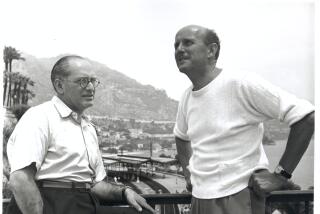THE CINEMA OF ADVENTURE, ROMANCE & TERROR <i> edited by George E. Turner (American Society of Cinematographers Press, P.O. Box 2230, Hollywood, Calif. 90078: $39.95; 298 pp.) </i>
- Share via
With the possible exception of Three Stooges movies, it’s hard to think of a film that could not be included in a collection entitled “The Cinema of Adventure, Romance & Terror.” George Turner, who edited this book of essays, has lumped together such diverse films as “All Quiet on the Western Front,” the “Flash Gordon” series, Alfred Hitchcock’s “Rope,” the silent World War I epic, “Wings,” and the cult classic, “The Black Cat” (1934 version).
In fact, it seems that, except for Turner’s description of his choices as “good old movies,” the only attribute these films share is a high level of technical accomplishment, especially in cinematography. No surprise here, as Turner has been the editor of American Cinematographer magazine since 1984. With loving detail, he describes how effects were achieved through skilled use of lighting, lenses, filters, process screens and models.
To the credit of Turner and the other writers, the technical descriptions are for the most part accessible to the lay movie buff.
Some of the behind-the-scenes anecdotes the writers relate, however, are suspect because the book is not footnoted and the sources (except past issues of American Cinematographer) go mostly unnamed. Hollywood anecdotes have a way of getting embellished over time, and if there was an effort to verify them, it’s not apparent in the text.
Nonetheless, it’s fun to read about the Spanish-language version of “Dracula” (shot on off-hours on the same set as the English-language version), the troubles on the set of “Gunga Din” and how the story logic in the plot of “The Black Cat” was sabotaged by director Edgar G. Ulmer, probably the wackiest genius in cinema so far.
The coffeetable book features an ample selection of beautifully reproduced photographs, and the production of the book (printed in Japan) is first-rate. It even has a sewn binding, once a book-industry standard, but now, sadly, increasingly rare.
More to Read
Only good movies
Get the Indie Focus newsletter, Mark Olsen's weekly guide to the world of cinema.
You may occasionally receive promotional content from the Los Angeles Times.











